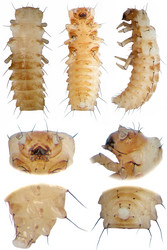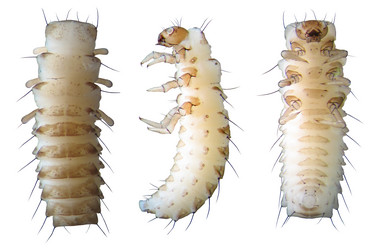Ischaliidae
Ischalia
Dmitry Telnov- Ischalia s. str. Pascoe 1860
- Ischalia apicalis Pic, 1912 - Myanmar, Thailand
- Ischalia aposana Satô, 2002 - Philippines (Mindanao)
- Ischalia atricornis Pic, 1938 - Malaysia, Philippines (Mindanao)
- Ischalia basalis Waterhouse, 1877 - Java, Sumatra
- Ischalia blairi Pic, 1912 - Sumatra, Thailand, Myanmar
- Ischalia bryanti Blair, 1914 - Borneo
- Ischalia caerulea Telnov, 2007 - Thailand
- Ischalia chinensis Young, 1976 - SE China
- Ischalia dimidiata Blair, 1920 - Philippines (Basilan)
- Ischalia fischeri Young, 2008 - Vietnam
- Ischalia gialaiensis Young, 2008 - Vietnam
- Ischalia indigacea Pascoe, 1860 - Borneo, Sumatra, Philippines (Palawan), Malaysia
- Ischalia philippina Blair, 1920 - Philippines (Luzon)
- Ischalia sasajii Satô & Ohbayashi, 2001 - Vietnam
- Ischalia sumaoi Satô, 2002 - Philippines (Mindanao)
- Ischalia yasuakii Satô, 2002 - Philippines (Mindanao)
- Ischalia zetteli Satô, 2002 - Borneo
- Eupleurida LeConte 1862
- Ischalia acco Satô & Ohbayashi, 2001 - Vietnam
- Ischalia aptera Gusakov & Telnov, 2007 - China (Sichuan)
- Ischalia arakii Saito, 2003 - Japan
- Ischalia arisana Kono, 1935 - Taiwan
- Ischalia brachyptera Nikitsky, 1994 - Russia (Primorie)
- Ischalia californica Van Dyke, 1938 - USA
- Ischalia costata LeConte, 1862 - USA
- Ischalia kunashirica Nikitsky, 1994 - Russia (S Kurile Islands)
- Ischalia latemarginata Ohbayashi & Toyama, 1994 - Taiwan
- Ischalia luteolineata Pic, 1912 - Japan
- Ischalia martensi Paulus, 1972 - Nepal
- Ischalia nigrovittata Pic, 1940 - Vietnam, Thailand
- Ischalia nepalensis Paulus, 1972 - Nepal
- Ischalia patagiata Lewis, 1887 - Japan, Korea, China
- Ischalia sichuanensis Young, 2008 - China (Sichuan)
- Ischalia suturalis Blair, 1912 - India (Assam)
- Ischalia takane Saito, 1994 - Japan
- Ischalia tsuyukii Ohbayashi & Toyama, 1994 - Thailand
- Ischalia uenoi Sato, 1990 - Taiwan
- Ischalia vancouverensis Harrington, 1892 - Canada, USA
Introduction
Ischaliidae is a small group of brightly coloured mid-sized beetles distributed in the Nearctic, Oriental and some parts of the Palaearctic regions. A single genus with two subgenera and 37 recent species are hitherto known. No fossil records have been discovered for this subfamily. A checklist of species of Ischalia, the single genus of the family, is given by Gusakov & Telnov (2007), followed by Young (2008).
Pronotum with lateral margins parallel from middle toward base. Basolateral angles strongly angulate. Base angulate at the middle. Pronotal disc with prominent ridges. Elytra flattened, with distinct discal and epipleural longitudinal ridges extending to apical third.
The role of Ischaliidae in ecosystems is not properly studied. Adults are diurnal, and commonly collected from green vegetation. Both imagoes and larvae of Nearctic species were observed to feed on fungal mycelium of decaying wood.
Characteristics
Adults
Body 3.80-7.50 mm long, ~2.0-2.40 times longer than wide. Body colouration usually metallic blue to yellow, reddish-brown or yellow. Pubescence of dorsal surface short and sparse, decumbent to subdecumbent.
Head moderately to strongly constricted posteriorly to eyes, but not forming narrow neck. Eyes not prominent, shallowly to deeply emarginate. Insertions of antennae exposed dorsally. Frontoclypeal suture slightly to strongly impressed. Antennae with 11 antennomeres, filiform to indistinctly clavate; antennomeres broad. Mandibles short and broad, bidentate at apex.
Pronotum 0.75-0.95 times as long as wide, widest across the middle or in basal part. Base distinctly narrower than elytral base, angulate medially. Lateral margins curved anteriorly, straight or almost straight posteriorly. Anterior angles not produced, basal angles slightly to strongly angulate. Pronotal disc with median carina or longitudinal groove. Procoxal cavities contiguous, open externally and internally.
Elytra ~1.70-1.90 times longer than their maximum combined width. Punctures of disc irregular. Elytral disc with more or less complete sutural, sublateral and epipleural costae. Epipleura incomplete. Elytral apices meet at suture. Mesocoxal cavities contiguous, open laterally. Metacoxal cavities narrowly to broadly separated, not expanded laterally to meet lateral margin of elytra. Hind wings (if present) with long apical field bearing four sclerites. Radial cell without basal edge.
Legs well developed, slender. Tibiae simple, not expanded apically. Tibial spurs paired, usually well developed. Tarsal formula 5-5-4. Penultimate tarsomere distinctly and deeply bilobate. Two to three tarsomeres covered with dense patches of hairs beneath.
Abdomen with 5 or 6 ventrites, the first two of them more or less connate. Ventrites I-VII with functional spiracles in their pleural membrane. Ventrite I not much longer than ventrite II. Aedeagus of inverted tenebrionoid type, symmetrical to slightly asymmetrical. and with ventral tegmen. Parameres partly to entirely fused together and to phallobase. Ovipositor with weakly indicated baculi.

Ischalia brachyptera. © 2006 Artem A. Zaitsev I thank Artem A. Zaitsev (Moscow Pedagogical State University) for permit to use this excellent photograph on ToL.
Preimaginal stages
Larva broadly elongate, slightly flattened dorso-ventrally. Dorsal surface with numerous dark granules or spicules. Head hypognathous, with sharply angulate frontoclypeal suture. Labrum fused to clypeus. Antennae 3-segmented. Terminal antennomere consist of terminal sensorium and sclerotized ring. Mandibles symmetrical apically bidentate.
Prothorax is not longer than combined lenght of meso- and metathorax. Legs well developed, consisting of 5 segments. Pretarsus claw-like.
Abdomen less than twice as long as thorax. Segment IX well developed, excluding appendages shorter than segment VIII. Laterotergites with annular spiracles.
Biology and Ecology
Ischaliidae are most diverse in tropical rainforests of Asia, but many species are also known from subtropical to temperate forest areas.
In the Oriental region, many Ischalia were observed by day sitting on green vegetation.
Discussion of Phylogenetic Relationships
In original the description of Ischalia Pascoe, 1860, this genus was placed with some doubt in Pedilidae (now Pedilinae of Pyrochroidae). The Nearctic genus Eupleurida LeConte, 1862 was originally described in Pyrochroidae. The two genera were synonymised in 1873 by LeConte.
Later, Blair (1920) considered the Old and New World groups to be distinct genera and established a new subfamily Ischaliinae within Pyrochroidae. Lawrence (1977) noted that Ischaliidae are very specific, but left them in Pyrochroidae, while Young (1985) moved this group to Anthicidae after description of larva for Ischalia. This was followed by Lawrence & Newton (1995).
Ischaliidae were raised to family rank by Nikitsky (1992) (not Nikitsky & Egorov as specified by Lawrence et al. 2010) and Nikitsky (1994). This was confirmed and followed in publications by Gusakov & Telnov (2007) and Young (2008).
Classification and Species List
Note: all taxa below are listed alphabetically.
Subgenus Ischalia sensu stricto: 17 species
- Ischalia apicalis Pic, 1912 - Myanmar, Thailand
- Ischalia aposana Satô, 2002 - Philippines (Mindanao)
- Ischalia atricornis Pic, 1938 - Malaysia, Philippines (Mindanao)
- Ischalia basalis Waterhouse, 1877 (= apicalis Blair, 1912; = apicalis lateapicalis Pic, 1912) - Java, Sumatra
- Ischalia blairi Pic, 1912 (replacement name for apicalis Pic, 1912) - Sumatra, Thailand, Myanmar
- Ischalia bryanti Blair, 1914 - Borneo
- Ischalia caerulea Telnov, 2007 - Thailand
- Ischalia chinensis Young, 1976 - SE China
- Ischalia dimidiata Blair, 1920 - Philippines (Basilan)
- Ischalia fischeri Young, 2008 - Vietnam
- Ischalia gialaiensis Young, 2008 - Vietnam
- Ischalia indigacea Pascoe, 1860 - Borneo, Sumatra, Philippines (Palawan), Malaysia
- Ischalia philippina Blair, 1920 (= insuturalis Pic, 1936) - Philippines (Luzon)
- Ischalia sasajii Satô, Ohbayashi, 2001 - Vietnam
- Ischalia sumaoi Satô, 2002 - Philippines (Mindanao)
- Ischalia yasuakii Satô, 2002 - Philippines (Mindanao)
- Ischalia zetteli Satô, 2002 - Borneo
Subgenus Eupleurida: 20 species
- Ischalia acco Satô, Ohbayashi, 2001 - Vietnam
- Ischalia aptera Gusakov, Telnov, 2007 - China (Sichuan)
- Ischalia arakii Saito, 2003 - Japan
- Ischalia arisana Kono, 1935 - Taiwan
- Ischalia brachyptera Nikitsky, 1994 - Russia (Primorie)
- Ischalia californica Van Dyke, 1938 - S USA
- Ischalia costata LeConte, 1862 - USA
- Ischalia kunashirica Nikitsky, 1994 - Russia (S Kurile Islands)
- Ischalia latemarginata Ohbayashi, Toyama, 1994 - Taiwan
- Ischalia luteolineata Pic, 1912 - Japan
- Ischalia martensi Paulus, 1972 - Nepal
- Ischalia nigrovittata Pic, 1940 - Vietnam, Thailand
- Ischalia nepalensis Paulus, 1972 - Nepal
- Ischalia patagiata Lewis, 1887 - Japan, Korea, China
- Ischalia sichuanensis Young, 2008 - China (Sichuan)
- Ischalia suturalis Blair, 1912 - India (Assam)
- Ischalia takane Saito, 1994 - Japan
- Ischalia tsuyukii Ohbayashi, Toyama, 1994 - Thailand
- Ischalia uenoi Sato, 1990 - Taiwan
- Ischalia vancouverensis Harrington, 1892 - Canada, USA
References
Gusakov A., Telnov D. 2007. Systematic Changes and New Species of Ischaliidae (Coleoptera). – Folia heyrovskyana, Series A, 15, No. 1: 39-46.
Lawrence J.F., Newton A.F., Jr. 1995. Families and Subfamilies of Coleoptera (with Selected Genera, Notes, References and Data on Family-Group Names): 779–1092 In: J. Pakaluk J., Slipinski S.A. (eds) Biology, Phylogeny, and Classification of Coleoptera: Papers Celebrating the 80th Birthday of Roy A. Crowson. Muzeum i Instytut Zoologii PAN, Warszawa.
Lawrence J.F., Escalona H., Leschen R.A.B. 2010. 11.29. Tenebrionoidea Incertae sedis: 750-760. In: Leschen R.A.B., Beutel R.G., Lawrence J.F. (eds) Coleoptera, Beetles. Volume 2: Morphology and Systematics (Elateroidea, Bostrichiformia, Cucujiformia partim). Arthropoda Insecta. Handbook of Zoology. De Gruyter, Berlin & New York.
LeConte J.L. 1862. Classification of Coleoptera of North America. - Smithsonian Miscellaneous Collections 3: 209-286.
LeConte J.L. 1873. Synonymical Remarks upon the North American Coleoptera. - Proceedings of the Academy of Natural Sciences of Philadelphia 25: 321-336.
Nikitsky N.B. 1992. Fam. Ischaliidae, stat. n. [Sem. Ischaliidae, stat. n.]. 497-498. In: Ler P.A. (chief ed.) Key to the insects of the Russian Far East. 3 Coleoptera part 2. [Opredelitel’ nasekomikh Dal’nego Vostoka Rossii. Zhestkokrylye, ili zhuki]. Nauka, St.-Petersburg (in Russian).
Nikitsky N.B. 1994. Two New Species of the Genus Ischalia (Coleoptera, Ischaliidae) from the Russian Far East. - Zoologichesky zhurnal 73, No. 6: 33-38.
Young D.K. 1985. Description of the Larva of Ischalia vancouverensis Harrington (Coleoptera: Anthicidae: Ischaliinae), with Observations on the Systematic Position of the Genus. - The Coleopterists Bulletin 39, No. 3: 201-206.
Young D. 2008. Three new Asian Species of Ischalia Pascoe, 1860 (Coleoptera: Ischaliidae), with a World Checklist of Subgenera and Species. – The Pan-Pacific Entomologist 83, No. 4: 321-331.
Title Illustrations

| Scientific Name | Ischalia brachyptera |
|---|---|
| Location | Russia: Primorie |
| Acknowledgements | I thank Dr. Kirill V. Makarov (Moscow Pedagogical State University) for this excellent photograph. |
| Specimen Condition | Dead Specimen |
| Identified By | D.Telnov |
| Sex | Male |
| Life Cycle Stage | imago |
| View | dorsal |
| Collection | Moscow Pedagogical State University |
| Collector | M.Smirnov |
| Source | Ischalia brachyptera Nikitsky, 1994 (Ischaliidae) - atlas of beetles of Russia |
| Copyright | © 2005 Kirill V. Makarov |
| Scientific Name | Ischalia brachyptera |
|---|---|
| Location | Russia: Primorie |
| Acknowledgements | I thank Artem A. Zaitsev (Moscow Pedagogical State University) for permit to use this excellent photograph on ToL. |
| Specimen Condition | Dead Specimen |
| Identified By | D.Telnov |
| Life Cycle Stage | larva |
| View | dorsal, lateral, ventral |
| Collection | Moscow Pedagogical State University |
| Collector | K.V.Makarov |
| Source | http://www.zin.ru/animalia/coleoptera/eng/ischbraz.htm |
| Copyright | © 2006 Artem A. Zaitsev |
About This Page
Dmitry Telnov

The Entomological Society of Latvia
Correspondence regarding this page should be directed to Dmitry Telnov at
Page copyright © 2010 Dmitry Telnov
All Rights Reserved.
- First online 19 October 2010
- Content changed 19 October 2010
Citing this page:
Telnov, Dmitry. 2010. Ischaliidae . Ischalia . Version 19 October 2010 (under construction). http://tolweb.org/Ischalia/66150/2010.10.19 in The Tree of Life Web Project, http://tolweb.org/














 Go to quick links
Go to quick search
Go to navigation for this section of the ToL site
Go to detailed links for the ToL site
Go to quick links
Go to quick search
Go to navigation for this section of the ToL site
Go to detailed links for the ToL site